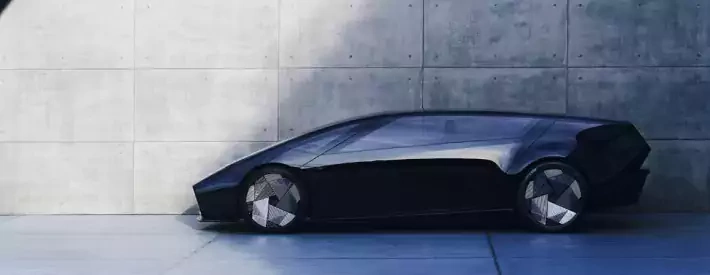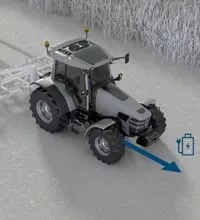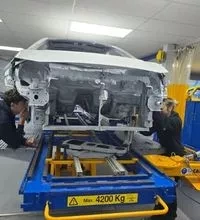CES: Five technologies set to shake up automotive

Flying cars, in-car entertainment gimmicks, awkward celebrity collaborations and lots of nonsense – in many ways, this year’s CES was much like last year’s. It wouldn’t feel like an industry event without e-VTOL prototypes everywhere, or an impassioned speech on why Generation Alpha need all their kitchen appliances to connect to the internet.
But that would only be half the story. Because for the mobility sector (of which the car industry is now a part) there were a number of high-profile surprises that will help shape the conversations we have about design, sustainability and personal transport for the next twelve months. Behind the predictable wall of fluff lurked some unexpected gems – the surprisingly lucid glimpses into our shared future that make CES the most influential show in the world.
1 Kia learns to skateboard
By rights, this should have happened a while ago. The ‘skateboard’ platform upon which EVs are so often based lends itself to precisely the kind of modular bodies that Kia demonstrated at CES this year with its “Platform Beyond Vehicle” concept. To the untrained eye, this is just a row of unimaginative electric vans, but underneath is quite an old idea dressed up for the electric age – an EV chassis cab, with a fixed driving position and space on the back for whatever the end customer might need.
At first, Kia has suggested a van, a bigger van, a minibus and something recognisably car-shaped. It says they’ll be distributed in kit form, which is exciting, and that other use cases will be factored in – particularly ride-hailing applications, which it seems to be majoring on. It’s easy to imagine more niche applications being catered for on a modular EV platform, like tippers and camper vans. A PBV-dedicated plant is scheduled to come online in 2025.
2 Samsung rolls out OLED
How much dashboard should we devote to screen space? Nobody seems to know, and while many manufacturers move away from touchscreen over-reliance in favour of old-fashioned physical knob and switch interfaces, customers apparently want big screens for TV and gaming when they’re parked.
Enter Samsung’s rollable OLED. Or rather, unfurl it – this strangely compelling tech is half TV, half parchment, rolling and unrolling as required by the user. In principle it means that the car’s dash can provide minimal information while the car is being driven, before unfolding to reveal a cinema-like display for the kids while you wait for a ferry. We’ve been able to rotate touchscreens in a few cars for years, but being able to adjust the physical size of the screen could represent significant progress in vehicle ergonomics and design.
3 AI is absolutely everywhere
Predictably, this year’s CES was an exercise in “what we can shoehorn AI into”. An AI fridge, an AI lawnmower, an AI cat flap, an AI mattress, an AI pillow to go with it and even an AI device that can decode and translate a baby’s cries – it all somehow makes the prospect of an AI Volkswagen Golf seem pretty sensible by comparison.
Volkswagen says its new Golf – along with the Tiguan, Passat and ID models – will have ChatGPT functionality. The AI chatbot will respond to your voice, dutifully adjusting climate and navigation systems or even answering general knowledge questions, as you require. The ability to swiftly settle back-seat arguments is moderately appealing, but given the state of LLMs at the moment, it’s hard to feel overly optimistic for the many manufacturers – including Mercedes and Honda – just starting out on their AI journeys.
4 Honda debuts 0 Series
It’s probably the best-looking machine at CES. Honda’s 0 Series saloon is what concept cars used to be – very sleek, very futuristic and undeniably desirable. The slightly retro overtones are what make the 0 Series – a name, Honda says, that reflects the brief to “design an EV from zero”.
It’s definitely unlike anything else on sale. It’s apparently 90 percent production-ready, and will 90 percent stick to the show car’s appearance, designer Toshinobu Minami confirmed with Autocar. A larger van-like concept called the ‘Space-Hub’ joined the headline-grabbing saloon, previewing a slightly less exciting but far more practical new entrant to Honda’s EV line-up.
5 Hyundai wants to take off
Never mind the colossal amounts of energy required to get and stay airborne, nor the regulatory gap that leaves widespread VTOL uptake largely impossible – the great and good of the mobility world still hold a candle for the flying car future we’ve all promised ourselves for a little over a century. It wasn’t the only passenger-carrying aircraft at CES, nor was it the first time Hyundai has brought an e-VTOL concept to the show, but the S-A2 from Hyundai’s ‘Supernal’ flying corps is arguably one of the more promising ‘flying cars’ from the past few years.
Hyundai says the S-A2 will carry a pilot and up to four passengers, that it will be “as quiet as a dishwasher” during take-off, and that it will cruise at 120mph for up to 40 miles at a go. Obviously, I could attach a desk fan to a milk crate, declare it an “e-VTOL concept” and make the same claims; so far, nobody has ever really managed to get this tech off the ground. But Hyundai is one of the more legitimate outfits currently vying for a slice of the air taxi pie, and is well placed to give this (currently largely fanciful) technology a decent shot.




